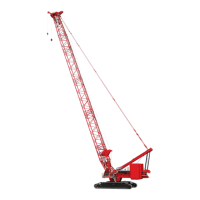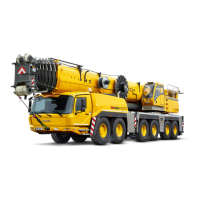HOISTS MLC650 SERVICE/MAINTENANCE MANUAL
5-34
Published 09-09-16, Control # 229-09
Drum 5 Lowering Operation
See Figure 5-19 and Figure 5-20.
To enable the control system to drive the drum 5 pump and
motor, the switches listed below must be in the stated
positions:
• Seat safety switch closed
• Drum 5 park switch in the OFF position
When the drum 5 joystick is moved in the hoist down
direction, a signal is sent to the IOLC33 control module via
the CAN Bus to ramp up the PWM duty cycle to the B-side
solenoid of the pump 6 EDC. The PWM signal is in
proportion to the speed commanded by the joystick.
Increasing the PWM duty cycle increases the pump
swashplate angle, which increases the hydraulic flow from
the B-side of the pump. From the pump, the flow is routed to
the A-side of the drum motor.
A signal is sent to the IOLC30 control module via the CAN
Bus to ramp up the PWM duty cycle to the drum 5 motor
controller. Increasing the PWM duty cycle decreases the
swashplate angle in the motor, which increases the motor
speed until the rotational speed is maximized based on the
pump flow.
The drum 5 motor speed sensor and pump 6 pressure
transducer (drum 5 psi) provide closed loop feedback to the
control units. The control algorithm uses this feedback to
adjust the pump and motor flows while ramping up to, and
maintaining, the speeds commanded by the joystick.
Drum 5 Pawl Operation
See Figure 5-18 and Figure 5-20.
The pawl is controlled by the park switch.
When the drum park is turned on to engage the drum pawl,
the CCMC11 control unit sends a 24 V
DC
output to the drum
5 pawl-in solenoid valve, energizing the solenoid. The drum
pawl solenoid valve shifts position to route hydraulic fluid
from the accessory pump 9 to the rod end of the pawl
cylinder. The cylinder rod retracts, engaging the drum pawl.
When the drum park is turned off to disengage the drum
pawl, the CCMC11 control module sends a 24 V
DC
output to
the drum 5 pawl-out solenoid valve, energizing the solenoid.
The drum pawl solenoid valve shifts position to route
hydraulic fluid from the accessory pump 9 to the tube end of
the pawl cylinder. The cylinder rod extends, disengaging the
drum pawl.
When the control system is not powered, the drum pawl
solenoid valve moves to the center position, allowing
hydraulic fluid at both ends of the pawl cylinder to return to
tank. Spring force holds the pawl in the engaged position.
